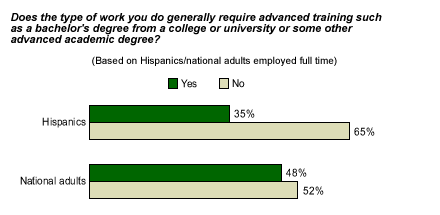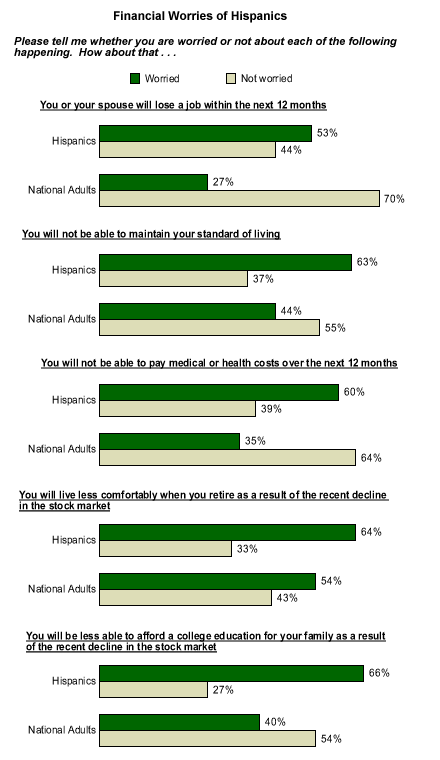The most recent U.S. census puts the country's Hispanic population at 32.8 million, about 12% of the total U.S. population. Two-thirds of the Hispanic population lists America's neighbor, Mexico, as their country of origin. Given the proximity of the country from which many Hispanics are immigrating, and the potential difficulties presented by people of differing cultures, languages, and socio-economic statuses immigrating to the United States, some policy-makers advocate putting stricter limits on immigration into the country. Others argue that the freedom to immigrate represents a value fundamental to American society, and that all people should be given an opportunity in this country.
Regardless of the partisan debate concerning future immigration policy, the burgeoning Hispanic population in America has changed, and will continue to change, the country's social, economic, and political landscape. Recent ���۴�ýpolling* of a sample of Hispanic residents (conducted in both English and Spanish) yields insights into the Hispanic population's education, employment, and financial status.
Educational Achievement
Educational success often yields economic opportunity in America, and education is especially important to Hispanic immigrants who may not speak fluent English upon arrival in the United States. How educated is the Hispanic population in America? More than half (56%) of the Hispanics ���۴�ýsurveyed reported having a high school education or less, including 32% who did not graduate high school. Of the 44% who reported having some college education, 15% said they were college graduates and 7% had pursued some postgraduate education.
These numbers translate almost directly into the workplace. When asked if the type of work they do requires advanced training such as a bachelor's degree or some other advanced academic degree, 35% of employed Hispanic adults say yes, while a majority (65%) says their work does not require advanced training. By comparison, the employed national adult population is more evenly divided -- 48% have jobs requiring advanced education and 52% do not.

Blue Collar or White Collar?
A greater understanding of the Hispanic population's current role in society is gained by looking at the type of work that employed Hispanics tend to do.
One poll question asked how often, if ever, a person's job requires him or her to work in an office. Among full-time employed Hispanics, 43% say "always" or "usually," while 57% say "rarely" or "never." These findings are roughly the reverse of those for all full-time employed American adults, 55% of whom say they always or usually work in an office and 44% of whom say they rarely or never do.
Another question asked whether the work a person does gets their clothes dirty. In response to this question, 41% of Hispanics employed full time answered "always," compared to a quarter (24%) of the full-time employed national adult population.
Financial Worries
The poll also asked Hispanics how much they worry about a variety of issues. The results show that Hispanics worry significantly more about financial concerns than American adults do as a whole. Significant differences exist on such items as fear of losing a job in the next 12 months, not being able to pay medical bills, inability to maintain your standard of living, the ability to live comfortably at retirement as a result of the recent decline in the stock market, and the ability to afford a college education for your family as a result of the recent decline in the stock market.

This is most likely attributable to the fact that many Hispanics live in low-income households, nearly half of Hispanics in the poll said their annual household income was below $30,000. In the larger adult population, just about a third have household incomes below $30,000. The financial concerns and income disparities of Hispanic Americans are probably rooted in lower educational achievement and diminished employment opportunities. As policy-makers seek to answer the questions raised by the high rate of immigration from Latino countries, their focus should include these two key factors. Reducing the level of financial worries reported by Hispanics may be a good barometer of success.
Additional Key Points
Politically, Hispanics are more likely to be Democrats (39%) than Republicans (19%). Hispanics are considered an important swing group in political circles, as a plurality (42%) identify themselves as independents.
Hispanics are also significantly less likely than other Americans to have money invested in the stock market. Specifically, 42% say they currently invest in the market, while 57% say they do not. Among national adults, 59% say they invest and 40% say they do not.
*Results are based on telephone interviews with 275 Hispanics, aged 18 and older, conducted Oct. 3-8, 2002. For results based on the total sample of Hispanics, one can say with 95% confidence that the maximum margin of sampling error is ±7%.
